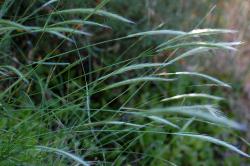- Taxon
- Gallery
Light green, ± stout, moderately tall, extravaginal tufts or rosettes, leaves < ± nodding, narrow-plumed culms. Leaf-sheath light brown, with minute, soft, appressed, retrorse hairs. Ligule 0.5–1.5 mm, membranous, abaxially minutely scabrid, ± truncate, minutely ciliate, occasionally asymmetric. Leaf-blade to 40 cm × 1.5–5 mm, somewhat stiff, flat or slightly inrolled, gradually tapered, strongly ribbed, abaxially scabrid near tip, adaxially minutely scabrid on margins and ribs. Culm (30)–50–100–(120) cm, internodes glabrous or minutely scaberulous below panicle. Panicle 10–25 cm, erect, spike-like, light green to stramineous, densely branched, close-set erect branches hidden by spikelets pulled together by entwining awns; rachis, branchlets and pedicels closely short-scabrid; spikelets numerous, shining. Glumes very narrow, linear-lanceolate, silvery; lower 4.5–8–(9) mm, ⊬ lemma, often shortly aristate, upper 5.5–8.5–(10) mm, ≥ lemma, tip acuminate. Lemma (4.5)–5–7–(8) mm, minutely scabrid, tip scarcely bifid; awn 20–30 mm, light green to purple, inserted 1.5–3 mm below lemma tip, column straight, awn ± falcate and twisted about once. Palea 3–5 mm, very narrow, keels minutely scabrid near ciliate tip. Callus hairs to 0.7 mm. Rachilla prolongation to 0.1 mm. Lodicules 0.5–0.7 mm, membranous, elliptic, acute, apically ciliate. Anthers 1–3, (0.7)–1.0–2.0 mm in chasmogamous flowers, 0.2–0.9 mm in cleistogamous flowers. Caryopsis 2.0–2.5 × 0.3–0.4 mm; embryo 0.3–0.4 mm; hilum 1.9–2.3 mm. 2n= 70.
[From: Edgar and Connor (2000) Flora of New Zealand. Volume 5 (second printing).]




